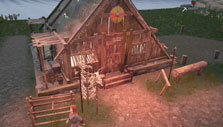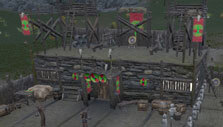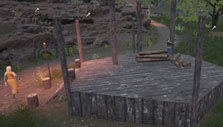Land of the Vikings
 by Aethyna
Nov 14, 2022 |
1
Votes |
73
Played |
0
Reviews
by Aethyna
Nov 14, 2022 |
1
Votes |
73
Played |
0
Reviews
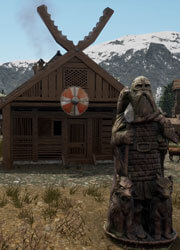 8
rate
Land of the Vikings is a sandbox-styled city builder where you play as the Jarl of a fledgling Viking settlement. Expand your village, advance your civilization, fulfill your people’s needs, and of course, defend it from enemies who would love to destroy all that you have built!
Play Now
Similar Games
Played
8
rate
Land of the Vikings is a sandbox-styled city builder where you play as the Jarl of a fledgling Viking settlement. Expand your village, advance your civilization, fulfill your people’s needs, and of course, defend it from enemies who would love to destroy all that you have built!
Play Now
Similar Games
Played
People Also Played






 Disclaimer: Land of the Vikings is currently in early access and understandably, this means that the game is still a work-in-progress and hence, will be treated as such. This is simply a first-impression preview of the game and we’ll definitely be updating our preview once the game is fully launched.
Disclaimer: Land of the Vikings is currently in early access and understandably, this means that the game is still a work-in-progress and hence, will be treated as such. This is simply a first-impression preview of the game and we’ll definitely be updating our preview once the game is fully launched. Summary
Land of the Vikings is a sandbox-styled city builder where you play as the Jarl of a fledgling Viking settlement. Expand your village, advance your civilization, fulfill your people’s needs, and of course, defend it from enemies who would love to destroy all that you have built!
Plotline
Similar to many sandbox-oriented games, Land of the Vikings lack a campaign mode and hence, doesn’t have any story to speak of. That said, in a way, you can create your own stories as you grow your Viking settlement by choosing the decisions that resonate with you the most whenever a critical event pops up in-game, be it an immigration of Viking refugees or dispute over water usage.
Gameplay
Before you start, the game will have you design, by combining premade symbols and a fixed palette of colors, your very own Viking crest. There are 14 different colors for both primary and secondary colors for you to choose from, along with a host of Viking-inspired symbols. Once done, you just need to input your village name and choose a map – there are several - that you’d like.
For me, I opted to go with the “tree of life” symbol since it looks the best both on the narrow banner as well as on the sail of a longboat. Not many of the symbols available here look as good when they are previewed on the banner, though most of them look brilliant on the sail.
Now, if you’ve played any medieval or Vikings-themed city builders before, Land of the Vikings should be a fairly easy-enough game to dive into. The goal here, like all city builders, is to grow your settlement from its humble origins into a bustling and efficient powerhouse of a city.
That being said, even if you’re not, the game comes with a helpful tutorial to guide you along as you play. Granted that the tutorial isn’t all-encompassing, it still did a solid job of setting down the foundations, especially when combined with the list of objectives that functions as a guide of sorts, of what you should do.
Constructing buildings here is quite straightforward. All construction works come in two stages, each requiring its own sets of materials. Only by completing both stages will the building be constructed. I’ve also noticed that building stuff takes a bit more time in this game even if you marked it as a priority, probably in the name of realism. After all, Rome wasn’t built in a day!
Most of the resources you need to start building come from the environment. You can use the Cut or Mine tool to have your unassigned workers, a.k.a. the Laborers, to chop down trees and mine for stones. Note that you can set the priority of these tasks, over other tasks the Laborers may perform, at the main longhouse. The downside here though is that you can’t cancel a Cut or Mine action once you’ve assigned them, which may clog up the task queue for your Laborers. I’m guessing this might be an oversight on the developers’ part and is something that they will be adding soon enough.
Unlike other similar games within the genre, however, Land of the Vikings opted to simplify the tree-regeneration process, by omitting the Forester and making it so that trees regrow naturally over time. This can be both a pro and a con - The pro includes taking out an additional building and the corresponding jobs from the production chain for logs and other wood-based items, while the con includes having cleared trees on a plot of land regrow before you could place the building you want to build there. Depending on which side of the coin you are on, you may like or dislike this game feature.
For stones, however, it’s a bit different since stones do not “grow back” over time. Instead, you’ll need to set up a stonepit to get unlimited stones from there. As you advance, you’ll unlock new resources which you can either gather/mine or produce, including dressed stone blocks, which are definitely sturdier than wood, and metal bars which in turn can be forged into metal tools and weapons.
Managing your people in this game may require some form of micromanagement, however. You see, although you can simply assign a certain number of workers for a certain production building via the very convenient Jobs menu, you might want to forgo taking the shortcut and assign each worker individually yourself. Why? Well, different production buildings in this game require workers with specific skill sets. For instance, the mill requires workers with a high Strength stat and by picking the right workers for the job, you can maximize the efficiency of the production, giving you more – in the case of the mill – bread.
Considering that you’ll need to grow your population quickly in order to support your rapid city expansion, the game helps you out by basically giving you new villagers via an in-game event. However, you do need to set up enough housing for your adult villagers to move out from their parents’ homes and have a new family of their own. These children will then grow up to become contributing members of your Viking society. This also means that elderly Vikings will die, opening up job positions for the new bloods to fill. The goal here is to have a net increase of villagers so you can match your village’s development with the appropriate population growth.
Besides having a nice variety, decorations are quite unique here as well, mainly through how you’ll be placing them. Similar to some city builders, decorations aren’t just for show and will actually contribute to enriching your people’s lives. Some decorations, when placed near roads, can increase travelling speed while others can improve the “Fame” of nearby homes and hence, your village as a whole.
Fame is very important in this game since it’s tied to your civilization’s advancement, specifically to the “Tree of Life”-styled technological tree at the bottom left of the screen. Though, besides decorations, the game seems rather vague as to how else you can earn more Fame. I assume building new houses and stuff would probably increase Fame as well, but it’s hard to know for sure.
I should also point out that, unlike some games, there’s no need for research here in Land of the Vikings. Instead, you can unlock new technologies, be it a shipyard to build boats and ships or the ability to start mining for stone and ore, instantaneously provided that you have the necessary Fame points.
The challenges of developing a village in tandem with your population’s needs aside, Land of the Vikings also throws some natural challenges your way, from thunderstorms to earthquakes. These natural disasters will usually destroy random buildings, forcing you to have to invest resources to repair them, though there are times when the option to repair is not available and you’ll have to manually rebuild the buildings instead.
Somewhere late mid-game, you’ll be able to unlock the option to build a training camp. Here, you can then train your villagers to become Viking warriors like archers and light infantry. Similar to other production buildings, there are specific stats requirements for your warriors to be more efficient at their jobs.
However, not everyone is available to be drafted into your army. Apparently, only those who volunteered will have their names show up on the list of potential recruits. Training warriors also require specific gear, namely weapon and armor, so you’ll need to have those ready by setting up the tailor and the blacksmith.
Besides patrolling your village when they are idle, these warriors can also be sent out on expeditions – you do play as a Viking, after all, and fighting is in their blood – to visit neighboring villages either to pillage or to establish contact so that your traders can set up a trade route. Of course, in order to do all of these, you’ll first need to unlock the necessary technological advancement at the Tree of Life.
As fun as the game was, however, Land of the Vikings is currently in early access and as such, there are definitely plenty of room for improvement. Some features are missing, such as the ability to unassign a Cut or a Mine task or the ability to see the area of effect of the water well while building new homes. More content is also needed to give the game more depth, such as more variety for in-game events.
Graphics/ Sound
The graphics here are pretty good, even if you’re running the game at Medium graphics settings instead of Epic. The buildings, at least the exterior, are incredibly detailed. Though, at one point, I zoomed into the insides of the mill and see two of my millers just meandering around in an empty room. In terms of sound, the game features some fantastic Viking-themed soundtracks that are supplemented with ambiance. However, having birds or crickets loudly chirping almost non-stop over the soundtrack even during the peak of winter doesn’t seem all too realistic.
Conclusion
All in all, Land of the Vikings has a promising early access title with a solid foundation that made my playthrough of the game so entertaining. However, as the game is still a work-in-progress, it is natural to point out that the game itself has plenty of room to improve. Hopefully, by gathering feedback from their players during early access, the developers will be able to shape this game into another hit indie city-builder that’s on par with popular breakout indies like Banished.
Land of the Vikings Blog
New Game Added: Land of the Vikings
 by Aethyna
Nov 14, 2022
by Aethyna
Nov 14, 2022


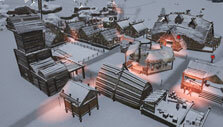 Read More
Read More
Featured Games
 Realm of Warriors
Assemble a party of the strongest heroes to take on both the rebel forces and the corrupting influence of the Dragon Demon in this Chinese-themed browser MMORPG, Realm of Warriors!
Realm of Warriors
Assemble a party of the strongest heroes to take on both the rebel forces and the corrupting influence of the Dragon Demon in this Chinese-themed browser MMORPG, Realm of Warriors!
 RAID: Shadow Legends
Recruit the best to join your team and take on Siroth, the Lord of Darkness himself!
RAID: Shadow Legends
Recruit the best to join your team and take on Siroth, the Lord of Darkness himself!
 Hustle Castle
Save the king and his daughter from the abyssal lord as he threatens to destroy your kingdom and marry your bride to be in this fun mmo simulation game.
Hustle Castle
Save the king and his daughter from the abyssal lord as he threatens to destroy your kingdom and marry your bride to be in this fun mmo simulation game.
 Dark Genesis
Play Dark Genesis and save the world from destruction with your allies.
Dark Genesis
Play Dark Genesis and save the world from destruction with your allies.
 War Robots
Head into the cockpit of a mech and decimate opponents in War Robots.
War Robots
Head into the cockpit of a mech and decimate opponents in War Robots.
 Blade of Kings
Blade of Kings is an idle RPG by Esprit Games. You’ll take a role of a warrior, defending the land from hordes of monsters and attempting to rise in rank in the kingdom. Take part in action-packed idle battles, use a variety of skills, raise pets, and achieve victory.
Blade of Kings
Blade of Kings is an idle RPG by Esprit Games. You’ll take a role of a warrior, defending the land from hordes of monsters and attempting to rise in rank in the kingdom. Take part in action-packed idle battles, use a variety of skills, raise pets, and achieve victory.






